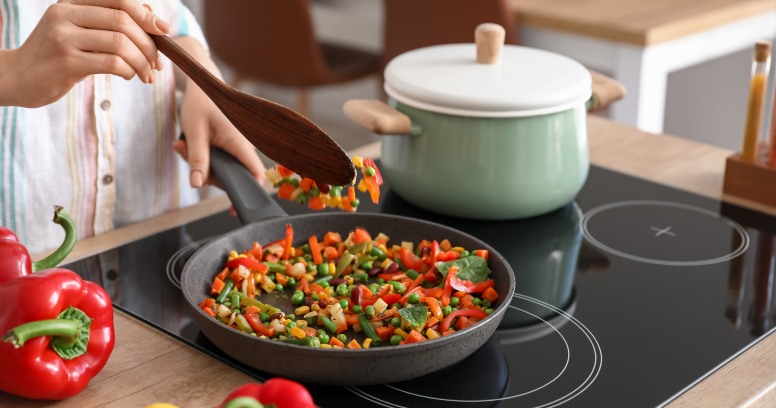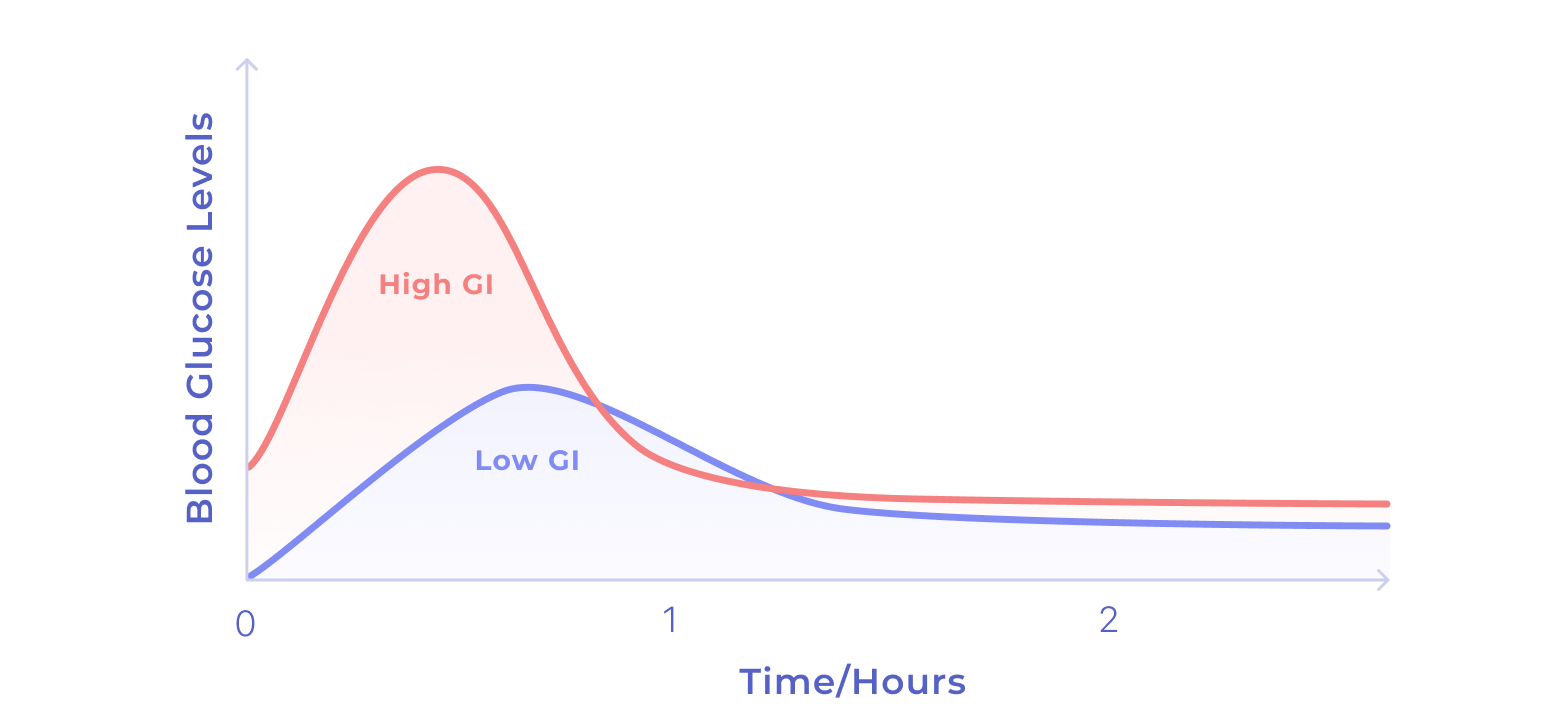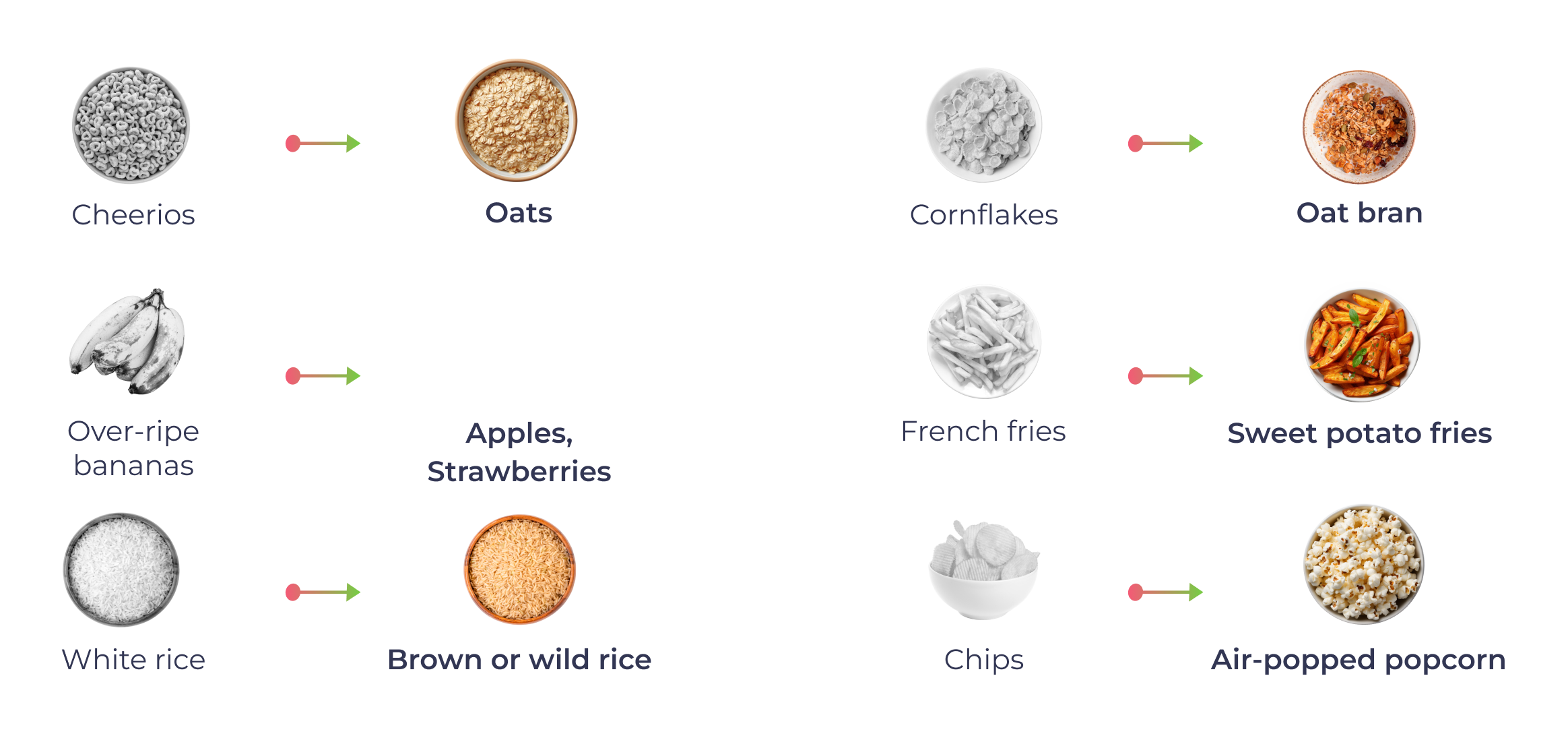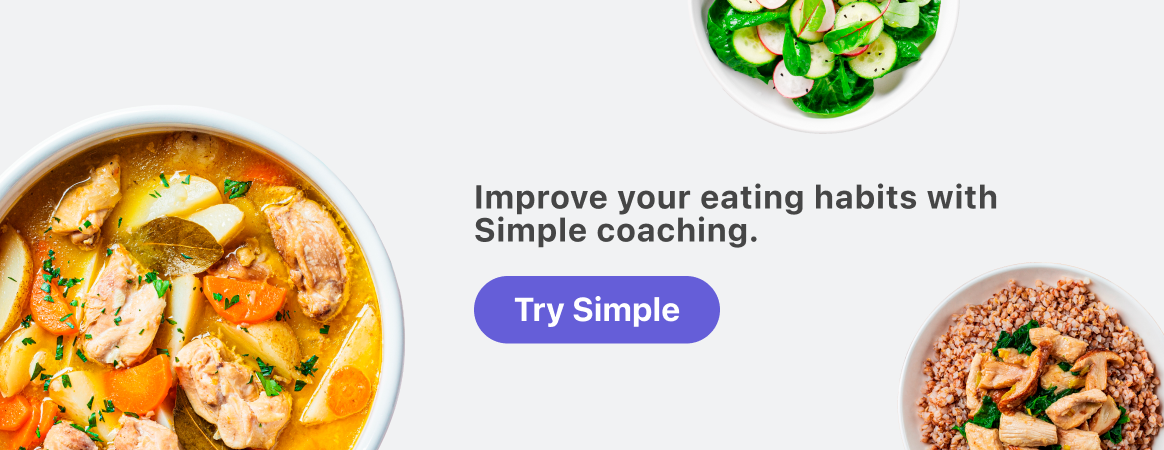What is the glycemic index, and why should you care?

Whether you’re trying to achieve certain health goals or just meet basic nutritional needs, chances are you’ve encountered the “healthy choice” confusion before.

It tends to happen at restaurants or grocery stores and looks like a choose-your-own-adventure of any or all of the following spiral-y thoughts:
- What’s a “healthy choice”?
- What’s a “healthy choice” for me?
- How do I even know what “healthy” looks like?
- What sort of factors should I consider when I’m making food decisions?
- Will I even like this so-called health-promoting choice?
While, unfortunately, only you can figure out the answer to that last one — it’s up to you to do some soul searching, educated guessing, and/or strategic meal planning — there are some ways to measure the health-promoting properties of different foods.
One of those is the glycemic index (GI).
So, what is a glycemic index, and what does “glycemic index” mean in practice? Let’s walk you through it.
What is the glycemic index?
Meet the glycemic index, or “GI” (no, not the action figure from your childhood). Think of the GI (sometimes called “the glucose index”) as a magic 8-ball for predicting how a specific food will impact your blood sugar (or blood glucose).[1]
We’ll dive into why that’s an important insight a bit later, but on a basic level, better blood sugar management — in particular, keeping it stable and avoiding peaks and crashes — can support a variety of health- and weight-related goals.
Foods that contain carbs impact your blood sugar differently than sources of pure fat or protein (like butter, poultry, nuts, and oils), so only foods with some amount of carbs are included in the glycemic index.
Foods that are digested quickly (like white rice, pastries, and other foods high in sugar and refined carbs) increase your blood sugar levels more by releasing glucose more rapidly into your bloodstream, so they rank higher on the glycemic index. By contrast, foods that are digested more slowly (like legumes, beans, or other carb sources that are high in protein, fiber, and/or fat) don’t spike your blood sugar levels as much, so they’ll have a lower GI rank.
You can put the GI to work when it comes to avoiding processed foods and encouraging more balanced eating, but if you need some health-promoting meal ideas or extra support in figuring out what eating routine (like intermittent fasting or a low-GI diet) might meet your specific health goals, we can help. Let us get to know what makes you tick through our Simple quiz, and we can dish out some personalized plate guidance.
Glycemic index calculations

If the idea of yet another thing to measure already has you giving us a major side eye, don’t worry: the calculations are already done for you, so you can put away that calculator. (We promise that no math, only food, is on the table when you’re referencing a food’s GI rank!)
To score a food using the GI, scientists give the person being studied a quantity of the food that contains 50 grams of carbs (not including fiber). The person is fasting so that no other foods impact the results, and their blood sugar is monitored for two hours after eating the food.
The scientists can then rank the food on a scale from 0 (no impact) to 100 (pure glucose).[2]
- Low-GI foods (55 or less) include fruits like apples, berries, oranges, and grapefruit, as well as whole grains (quinoa, oats, barley), legumes (green beans, kidney beans, lentils), and non-starchy vegetables (spinach, carrots, broccoli).
- Moderate GI foods (between 56 and 69) include foods like under-ripe bananas, pumpkin, popcorn, green peas, sweet potatoes, couscous, and macaroni.
- High-GI foods (70 or higher) include foods like bread (white bread, bagels, naan), rice (white rice, jasmine rice), baked goods (cake, cookies), starchy veggies (potatoes), some breakfast cereals, and candy.
Current glycemic index lists are pretty extensive, but they’re not exhaustive. You can still use them to get an idea of what other similar foods might score, however.
Limitations of the glycemic index system
While the GI system is a helpful guide, a number of variables can impact a food’s GI rank:[3]
- Preparation. Baked potato wedges have a GI of 54, while mashed potatoes have a GI score of 83.
- Ripeness. While an under-ripe banana has a GI score of 30, a ripe one scores 62 because the sugar content increases as fruits ripen.
- Other foods eaten simultaneously. You don’t realistically just eat one food at a time, so other foods can raise or lower the overall glycemic impact of a meal. For example, consuming protein (e.g., chicken), fiber (e.g., vegetables), or healthy fats (e.g., olive oil) with high-GI foods (e.g., white rice) can help slow down the digestion and absorption of carbohydrates, which leads to a more stable blood sugar.
- The amount of food eaten. The GI score comes from giving someone 50 grams of that food in one sitting. While that’s reasonable where rice and bread serving sizes are concerned, other foods would require some serious binging to hit the predicted spike in blood sugar. (For example, while pineapple has a GI of 58, a half-inch-thick slice contains about 7 grams of carbs — so a few slices won’t necessarily spike your blood sugar.)
Glycemic index charts and databases do account for some of these differences, but it’s not an exact science — especially when you factor in that everybody is unique. Things like your age, physical activity levels, insulin sensitivity, and how you digest food can also affect how your body reacts to carbs.
The glycemic index and carbohydrates
To understand the glycemic index meaning, you’ve first got to understand carbohydrates and how they work for us.
Carbs exist in the form of sugar, fiber, and starch in food, and they’re one of three macronutrients our body needs to keep us healthy (alongside protein and fat). They’re typically our primary energy source.
Every carbohydrate is a long chain of glucose molecules linked together, like a sugar necklace.[4] As soon as the carb hits your mouth, your body starts digesting and distributing it. Once it reaches your digestive tract, your body starts breaking down the sugars and starches into glucose, fructose, and galactose to use as energy. Meanwhile, undigested fiber passes through to keep your large intestine happy while smaller molecules get transported throughout your body to be used as energy or stored for later.
All carbs are not created equal
Unfortunately, not all carbs get processed in the same way,[4] so it’s not like your body has a one-way, one-stop train for each and every carb that comes to the station. Complex carbs (such as whole grains) take more effort to digest, whereas simple carbs (like white rice) take less effort. Think of it like an all-stops train vs. an express train.
The way your body digests carbohydrates directly correlates to the impact different foods have on your blood sugar. For example, high glycemic carbs like white rice will have a greater impact on your blood sugar than if you eat wild rice.[5] It’s easier for your body to digest the carbs in the white rice and make them accessible for energy, so the express train to digestion means your blood sugar will go up more rapidly.

All carbs impact your blood sugar, but some affect it more than others. The concept of the glycemic index can come in handy to help you determine which carbohydrates cause a spike in your blood sugar, which is something you want to avoid for certain health goals.
However, it’s important to remember that carbohydrates are meant to increase your blood sugar, and it’s something you want to focus on more if you have insulin resistance or type 2 diabetes. Remember to reach out for support from your healthcare provider if you want to focus on this more.
Benefits of the glycemic index
While the GI value of foods isn’t an exact plug-and-play strategy to level up your health, the glycemic index can be a valuable tool to help you strengthen awareness of how your body reacts to different foods and subsequently choose foods that will support your health goals and nutrition needs.
Glycemic index and chronic disease
Choosing foods with low GI scores typically means eating less processed food, and processed foods are often linked to chronic disease.[6]
While the evidence is still mixed about whether a low-GI diet can improve your health and lower your risk of certain chronic diseases (some studies show it can improve multiple health markers, like your blood pressure and insulin sensitivity,[7] while others suggest that may not be the case),[8] it’s still a helpful system for learning about the carb content of different foods.[9]
Glycemic index and diabetes
If you have type 1 or type 2 diabetes, your body doesn’t process sugar as efficiently as it should and eating large amounts of high-GI foods can be detrimental to your metabolic and cardiovascular health.[10,11] It may also lead to hyperglycemia (aka high blood sugar).[12]
Using the GI to gain a deeper understanding of carb content may be beneficial in helping you manage your blood sugar levels,[13] but it should never be a substitute for medical advice. If you’re considering changing up your lifestyle or eating habits to help manage your diabetes, you should always check in with your doctor first.
The same is true for any food routine you want to take for a test run, like intermittent fasting for diabetes. If your healthcare team is on board, we’re here to support you through the shifts, learn more about key elements of the process (like intermittent fasting and insulin and intermittent fasting and blood sugar), and answer common questions like “Does intermittent fasting slow metabolism?” Just head over to our Simple quiz to get started.
Glycemic index and weight loss
Prioritizing foods that have low GI rankings and limiting processed foods and refined carbs with high GI scores may support weight loss for people living with overweight or obesity.[14] It also may be more effective for reducing body weight than an eating routine that focuses on low-fat foods.[15]
However, more research is needed to understand how the GI system can be used in longer-term weight management.
Glycemic index and liver health
Focusing on low-GI foods may reduce liver fat and liver enzyme levels in people with non-alcoholic fatty liver disease,[16] particularly people who have diabetes or insulin resistance.[17]

What is glycemic load?
If you are up for some (very limited, calculator-friendly) math, there is a way to get a more realistic view of how different foods might influence your blood sugar based on what and how much you eat.
It’s called glycemic load (GL), and the formula looks like this:[9]
GL = (GI / 100) x (net grams of planned carbohydrates)
This calculation factors in both portion size and GI ranking, so it resolves the glycemic index variable around the amount of carbs in question you actually eat.
The GL ranking scale follows the same format as the GI ranking scale, but the values are different:
- Low GL scores are 10 or less.
- Moderate GL scores are between 11 and 19.
- High GL scores are greater than 20.
Glycemic load in action
Let’s look at how we take our “what is glycemic index” understanding and turn it into glycemic load practice.
Maybe you’re having ten strawberries as a snack. Each strawberry has 1.0 grams of carbs (so you’re having a total of 10 grams of carbohydrates), and the GI for strawberries is 40.
To find the GL, divide 40 by 100 and then multiply that by 10. That leaves you with a GL of 4, which is well within the low GL category.
Tips on incorporating GI and GL into a healthy lifestyle
The definition of “healthy” is like your favorite song; everyone has a different one. What it means is up to you, your body, and your healthcare team to define, glycemic index and glycemic load principles are fairly easy to apply in four ways:
- Assess the foods you typically consume. Are you an oatmeal fiend? A diehard pasta lover? An apple-a-day kind of person? Familiarize yourself with the GI information of your staples with the help of a glycemic index list or database.
- Maintain level blood sugar. To keep your blood sugar as stable as possible throughout the day, aim to eat foods that are low to moderate on the glycemic index, and don’t forget to eat regularly throughout your eating window.
- Aim for balance, not avoidance. Trying to cut out all high-GI foods (or carbs entirely) likely isn’t sustainable. Instead, pair high-GI foods with foods high in protein, fat, and fiber to help slow your body’s digestion of that carb influx. If you’re craving mashed potatoes (GI 83), rather than slowing your roll (er, potato?), balance it with things like boiled carrots (GI 39) and roasted turkey.
- Try swapping high-GI foods for low-GI alternatives. Particularly if you find yourself reaching for those high-sugar, high-starch carbs more often than not, some substitutions may be a simple way to strike more of that balance.
Some of our favorite carb changes:


- Brouns F, Bjorck I, Frayn KN, Gibbs AL, Lang V, Slama G, et al. Glycaemic index methodology. Nutr Res Rev. 2005 Jun;18(1):145–71.
- Arvidsson-Lenner R, Asp NG, Axelsen M, Bryngelsson S, Haapa E, Järvi A, et al. Glycaemic index. Scand J Nutr. 2004 Jan;48(2):84–94.
- Kanter M, Angadi S, Miller-Jones J, Beals KA. Limitations of the glycaemic index and the need for nuance when determining carbohydrate quality. Cardiovasc Res. 2022 Mar 25;118(5):e38–9.
- Holesh JE, Aslam S, Martin A. Physiology, Carbohydrates. StatPearls Publishing; 2023.
- Augustin LSA, Kendall CWC, Jenkins DJA, Willett WC, Astrup A, Barclay AW, et al. Glycemic index, glycemic load and glycemic response: An International Scientific Consensus Summit from the International Carbohydrate Quality Consortium (ICQC). Nutr Metab Cardiovasc Dis. 2015 Sep;25(9):795–815.
- Jardim MZ, Costa BV de L, Pessoa MC, Duarte CK. Ultra-processed foods increase noncommunicable chronic disease risk. Nutr Res. 2021 Nov;95:19–34.
- Radulian G, Rusu E, Dragomir A, Posea M. Metabolic effects of low glycaemic index diets. Nutr J. 2009 Jan 29;8:5.
- Sacks FM, Carey VJ, Anderson CAM, Miller ER 3rd, Copeland T, Charleston J, et al. Effects of high vs low glycemic index of dietary carbohydrate on cardiovascular disease risk factors and insulin sensitivity: the OmniCarb randomized clinical trial. JAMA. 2014 Dec 17;312(23):2531–41.
- Vega-López S, Venn BJ, Slavin JL. Relevance of the Glycemic Index and Glycemic Load for Body Weight, Diabetes, and Cardiovascular Disease. Nutrients [Internet]. 2018 Sep 22;10(10).
- Giugliano D, Ceriello A, Esposito K. Glucose metabolism and hyperglycemia. Am J Clin Nutr. 2008 Jan;87(1):217S – 222S.
- Hanssen NMJ, Kraakman MJ, Flynn MC, Nagareddy PR, Schalkwijk CG, Murphy AJ. Postprandial Glucose Spikes, an Important Contributor to Cardiovascular Disease in Diabetes? Front Cardiovasc Med. 2020 Sep 18;7:570553.
- Mouri M, Badireddy M. Hyperglycemia. StatPearls Publishing; 2023.
- Vlachos D, Malisova S, Lindberg FA, Karaniki G. Glycemic Index (GI) or Glycemic Load (GL) and Dietary Interventions for Optimizing Postprandial Hyperglycemia in Patients with T2 Diabetes: A Review. Nutrients [Internet]. 2020 May 27;12(6).
- Zafar MI, Mills KE, Zheng J, Peng MM, Ye X, Chen LL. Low glycaemic index diets as an intervention for obesity: a systematic review and meta-analysis. Obes Rev. 2019 Feb;20(2):290–315.
- Juanola-Falgarona M, Salas-Salvadó J, Ibarrola-Jurado N, Rabassa-Soler A, Díaz-López A, Guasch-Ferré M, et al. Effect of the glycemic index of the diet on weight loss, modulation of satiety, inflammation, and other metabolic risk factors: a randomized controlled trial. Am J Clin Nutr. 2014 Jul;100(1):27–35.
- Parker A, Kim Y. The Effect of Low Glycemic Index and Glycemic Load Diets on Hepatic Fat Mass, Insulin Resistance, and Blood Lipid Panels in Individuals with Nonalcoholic Fatty Liver Disease. Metab Syndr Relat Disord. 2019 Oct;17(8):389–96.
- Valtueña S, Pellegrini N, Ardigò D, Del Rio D, Numeroso F, Scazzina F, et al. Dietary glycemic index and liver steatosis. Am J Clin Nutr. 2006 Jul;84(1):136–42; quiz 268–9.
